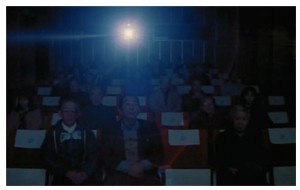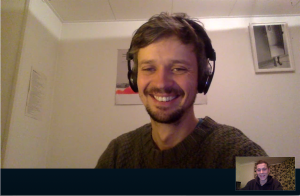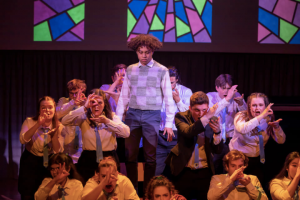
The Age of the ‘Subversive’ Great Gatsby
by Irina Radulet | June 10, 2023
Sometimes it seems our epoch is slowly running out of ideas. First came the slew of remakes – Disney films, old Hollywood classics, all went under Netflix’s dollar-bloated hammer. Now, when adapting the classics for the screen or for the stage, there seems to be a desire to find some unique angle, some boundary-breaking USP to differentiate the adaptation from the original. When done well, this adds depth and richness to an already well-loved story. When executed poorly, it feels more like the director is clamouring “I too have something new to say!” in a room where nobody is listening. This month, I attended two adaptations of The Great Gatsby, both claiming to add something unique to Fitzgerald’s novel. The first was a Northern Ballet adaptation, in which Fitzgerald’s tender dialogue was expressed solely through dance. The second was the Oxford Playhouse student production, featuring a female Gatsby, which rendered Gatsby’s relationship with Daisy even more taboo. Looking at each production in turn, I propose a forensic analysis of whether these adaptations actually had anything new to say.
Showing at London’s Sadler’s Wells, the Northern Ballet Gatsby first premiered in 2013, the same year that Baz Luhrmann’s film was released. This is significant, as it means the production enjoyed relative independence from Luhrmann’s, and had sufficient breathing room to find its own feet (no pun intended) in this story told solely through dance. It is choreographed, directed, and designed by David Nixon CBE, who seems to be something of a polymath. Adapting a story as linguistically rich as Fitzgerald’s, whose language pours like honey through the novel’s pages, you will inevitably ask yourself how to convey character when you are restricted to movement. The protagonists do this with limited degrees of success. Tom is the only one who acts; the others are mere dancers – or worse, if they attempt to act, it’s by freezing their faces into a salesman-like smile that must hurt their gums. For the most part, Gatsby (a dynamic role, you would have thought) just stands there, either wringing his hands or gazing longingly, about as charismatic as a cardboard cut-out. Daisy is a brilliant dancer – she floats in like a breath of air – but expressively she is immobile. The only time when the dance adaptation adds poignancy to the story is when Gatsby stumbles over a chair after seeing Daisy for the first time in five years. Only she, it seems, can ruffle the dancer’s composure.
What the Northern Ballet adaptation lacks in characterisation, it amply makes up for in visuals. The costumes, inspired by Chanel, are to die for: silky dresses and white satin waistcoats that shimmer like the wings of insects. The scenes of New York foot traffic are perfectly executed. Men stalk the stage with their chins sunk into their trench coats, while women with shawls and handbags prance along like poodles. The use of set design is similarly impressive. There are very frequent changes of set, a rolling catalogue of backgrounds that seem to fall out of the sky. In one scene, a wonderfully distorting glass panel makes a pantomime out of Gatsby and Daisy’s dance: she with a towering Georgian hairdo, he in blown-up pantaloons. In another, the pale yellows and pinks of the set make you feel like you’re trapped in a giant confectionery box, the gilded cage of the West Egg wealthy. It’s a sumptuous visual feast that more than makes up for the lack of dialogue.
The Oxford Playhouse adaptation, co-directed by Mina Moniri and Peter Todd, is executed on an impressive scale for a student production. This doesn’t always make it better: some scenes, such as when confetti falls on the audience, are just plain cheesy. There are also times when it seems it’s bitten off more than it can chew, awkwardly integrating elements of dance and acapella into the show. The main problem with this adaptation, in my opinion, is that it stalks the tracks of the bombastic Baz Luhrmann adaptation rather than those of the sensitively written Fitzgerald novel. Entire scenes and dialogues are lifted directly from the film. It towers like the Oculist over this production, taking some of the fairy dust away from Fitzgerald’s writing.
The acting is, for the most part, solid. Nick (Ethan Bareham) is perfect as the hapless protagonist thrust into a licentious world that he must learn how to navigate. Jordan, though a peripheral character, was played masterfully by Eleanor Dunlop. Her finger-curls, smoky voice, and complete, cool command over her character made the performance one of the most memorable. Roman Pitman as Tom was physically swaggering and verbally patronising – it wouldn’t have been unreasonable to think he was born with a glass of neat whiskey already in his hand. His slight hand twitch just before he slaps Myrtle was wonderfully executed. The main characters, however, were comparatively disappointing. Lily Carson was a somewhat stiff Daisy, and there was not even the semblance of chemistry between her and Gillian Konko’s Gatsby. Their dance routine was rather more awkward than romantic, and there was no need for such a proliferation of “I love yous” and gooey glances. It seems that this Gatsby underwent the glitzy musical makeover.
The fact that Gatsby is a woman is pitched as the “best-kept secret”, except it’s not, being advertised as the USP of this play. The gender change, though an interesting concept, feels ushered in rather than properly explored. Gatsby’s origins are now “Julia Gatz, the farmer’s daughter”. The fact that Miss Gatsby somehow served an officer in the army during the war is not satisfactorily explained, just glossed over. This equally applies to some interesting commentary on Fitzgerald’s own relationship with his wife Zelda. As Jordan confides to Nick, “The only ideas of Tom’s that hold water are the ones he’s stolen from his wife.” It’s a not-so-subtle reference to Fitzgerald’s alleged plagiarising from Zelda’s diary pages. It’s a thought-provoking observation, and one which deserves fleshing out more, but it’s quickly abandoned by the narrative way-side.
Though both productions had their merits, it seems to me that they failed to capitalise on precisely the things that differentiated them from the original Gatsby. The Oxford Playhouse production should have stepped out from Baz Luhrmann’s shadow, and interrogated Gatsby’s gender change properly, rather than posing questions and immediately discarding them. The Northern Ballet adaptation could have done more physically beyond just dancing – an example of this would be Tom’s hand twitch in the Oxford Playhouse production, which would have worked brilliantly if used by the Northern Ballet. It seems that Gatsby continues to raise intriguing questions as source material – but these must be done justice when reinterpreted for our generation.
The Great Gatsby, performed by the Northern Ballet, was showing at Sadler’s Wells, 16-20 May 2023.
The Great Gatsby, directed by Mina Moniri and Peter Todd, is showing at the Oxford Playhouse, 7-10 June 2023.
Words by Irina Husti-Radulet.
Photography by Scar Theatre.




